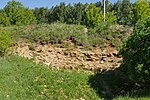Conodonts (Greek kōnos, "cone", + odont, "tooth") are an extinct group of jawless vertebrates, classified in the class Conodonta. They are primarily known...
44 KB (4,113 words) - 19:32, 31 August 2024
Conodonts are an extinct class of animals whose feeding apparatuses called teeth or elements are common microfossils found in strata dating from the Stage...
20 KB (2,203 words) - 10:13, 15 April 2024
The conodont feeding apparatus is a series of phosphatic-mineralized elements, resembling a set of “teeth”, which are found lining the oral surface of...
12 KB (1,354 words) - 11:38, 27 February 2023
subphylum Vertebrata, consisting of both living (cyclostomes) and extinct (conodonts, anaspids, and ostracoderms, among others). Among recent animals, cyclostomes...
42 KB (2,716 words) - 14:48, 7 October 2024
Willi Ziegler (redirect from Catalogue of Conodonts)
paleontologist. In 1969, he described the conodont genus Protognathodus. In 1984, with Charles A. Sandberg, he described the conodont genus Alternognathus. In 2002...
2 KB (208 words) - 21:37, 2 January 2022
Palmatolepis triangularis conodont zone, but later studies showed that P. triangularis first appeared slightly later than the main conodont turnover in the GSSP...
9 KB (862 words) - 15:28, 12 March 2024
subdivisions in 1974. The boundaries were established by the fauna of conodonts and/or graptolites. In 1995, the Subcommission on Ordovician Stratigraphy...
41 KB (4,051 words) - 19:54, 27 September 2024
mapmaker. She devised the Conodont Alteration Index, a method of determining the heat exposure of buried rock, by analyzing conodont fossils. Her work, which...
17 KB (1,762 words) - 00:11, 13 October 2024
The Conodont Alteration Index (CAI) is used to estimate the maximum temperature reached by a sedimentary rock using thermal alteration of conodont fossils...
3 KB (245 words) - 03:05, 14 June 2024
This is a list of conodonts genera, sorted in alphabetical order. †Acanthodus †Acodus †Acuminatella †Alternognathus †Amorphognathus †Ancyrodella †Ancyrognathus...
4 KB (163 words) - 14:30, 24 August 2022
Montagne Noire, southern France. It is defined by the first appearance of the conodont Siphonodella sulcata within the evolutionary lineage from Siphonodella...
114 KB (11,979 words) - 20:36, 14 October 2024
Prioniodontida (redirect from Complex conodonts)
Prioniodontida, also known as the "complex conodonts", is a large clade of conodonts that includes two major evolutionary grades; the Prioniodinina and...
3 KB (238 words) - 01:50, 12 January 2023
Evolution of fish (section †Conodonts)
Haikouichthys. During the late Cambrian, eel-like jawless fish called the conodonts, and small mostly armoured fish known as ostracoderms, first appeared...
47 KB (4,515 words) - 18:06, 7 July 2024
Gulch Limestone. It was once thought to be the first body fossil of a conodont, based on what turned out to be its gut contents; it is now thought to...
5 KB (532 words) - 15:26, 29 June 2024
The base of the Changhsingian Stage is at the first appearance of the conodont species Clarkina wangi. The global reference profile is profile D at Meishan...
16 KB (1,364 words) - 16:18, 25 June 2024
Pander Society (redirect from European Conodont Symposia)
informal organisation founded in 1967 for the promotion of the study of conodont palaeontology. It publishes an annual newsletter. Although there are regular...
3 KB (269 words) - 07:41, 3 April 2023
appearance of conodont species Declinognathodus noduliferus. The top of the stage (the base of the Moscovian) is at the first appearance of the conodonts Declinognathodus...
7 KB (525 words) - 13:43, 8 July 2024
was the driest. Reconstruction of tropical sea surface temperature from conodont apatite implies an average value of 30 °C (86 °F) in the Early Devonian...
69 KB (7,566 words) - 14:59, 16 October 2024
isolated rocks: this technique is called biostratigraphy. For instance, the conodont Eoplacognathus pseudoplanus has a short range in the Middle Ordovician...
102 KB (10,183 words) - 15:37, 3 October 2024
fossil record. During the late Cambrian, other jawless forms such as conodonts appear. Jawed vertebrates appear in the Silurian, with giant armoured...
102 KB (10,241 words) - 20:59, 16 October 2024
the period there were mass-extinction events that seriously affected conodonts and planktonic forms like graptolites. The trilobites Agnostida and Ptychopariida...
81 KB (7,797 words) - 19:52, 27 September 2024
Xiaowa Formation (section Conodonts)
Formation, forming a lagerstätte known as the Guanling biota. Ammonoids and conodonts found in the formation constrain its age to the early Carnian. Reptiles...
26 KB (1,589 words) - 09:41, 21 September 2024
with a mass extinction, which was particularly severe in the oceans; the conodonts disappeared, as did all the marine reptiles except ichthyosaurs and plesiosaurs...
71 KB (7,717 words) - 19:20, 13 October 2024
fishes), although this corresponded to sharp decline of jawless fish such as conodonts and ostracoderms. The Silurian system was first identified by the Scottish...
59 KB (5,803 words) - 16:02, 15 October 2024
span formality Formal Lower boundary definition First appearance of the Conodont Hindeodus parvus. Lower boundary GSSP Meishan, Zhejiang, China 31°04′47″N...
41 KB (4,325 words) - 04:33, 24 August 2024
Mazzaella is an extinct genus of Late Triassic ozarkodinid conodonts in the family Gondolellidae. They are found in mid-Julian sediments of the Tethys...
4 KB (369 words) - 22:06, 15 February 2023
datum of specific species of conodont, an enigmatic group of jawless chordates with hard tooth-like oral elements. Conodonts are used as index fossils for...
115 KB (11,882 words) - 19:46, 27 September 2024
appearance of the conodont Streptognathodus zethus. The top of the stage (the base of the Permian system) is at the first appearance of the conodont Streptognathodus...
7 KB (484 words) - 17:19, 31 August 2024
The Šilalė Event was an extinction event affecting conodonts during the Přídolí, the final stage of the Silurian period. The Šilalė Event, first identified...
4 KB (435 words) - 18:48, 28 May 2024
Cephalochordata (see diagram under Phylogeny). Extinct taxa such as the conodonts are chordates, but their internal placement is less certain. Hemichordata...
58 KB (5,211 words) - 01:20, 17 October 2024
















